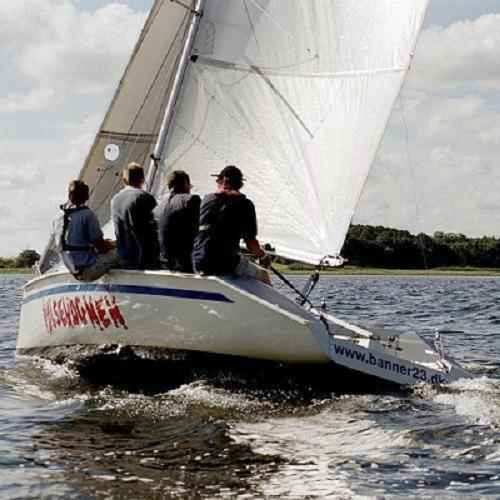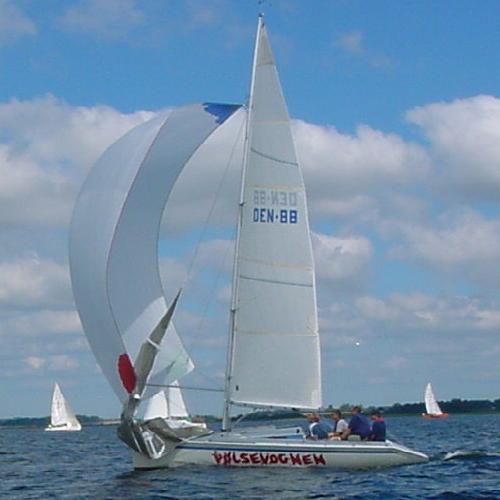Review of Banner 23

Basic specs.

Looking for a new boat? Find a Banner 23 or similar boat for sale
Both the hull and the deck is made of fibreglass. Generally, a hull made of fibreglass requires only a minimum of maintenance during the sailing season. And outside the sailing season, just bottom cleaning and perhaps anti-fouling painting once a year - a few hours of work, that's all.
The hull is a double hull which improves the indoor climate. Especially when the water is colder than the air in the cabin, then the double hull insulates against cold water and reduce the condense water in the cabin.
The deck is a double deck which improves the indoor climate.
The interior is like many other boats made of mahogany. Mahogany belongs to the hardwood species, known for being water-repellent and resistant to decay. It has an attractive wood grain and holds wood polish and varnish well.
The boat is equipped with 4 berths.

The Banner 23 is equipped with a fractional rig. A fractional rig has smaller headsails which make tacking easier, which is an advantage for cruisers and racers, of course. The downside is that having the wind from behind often requires a gennaker or a spinnaker for optimal speed.
Fin keel
The Banner 23 is equipped with a fin keel. The fin keel is the most common keel and provides splendid manoeuvrability. The downside is that it has less directional stability than a long keel.
The keel is made of lead. Compared with iron, lead has the advantage of being 44% heavier, which allows a smaller keel and hence less water resistance and higher speed.
The boat can enter even shallow marinas as the draft is just about 1.23 - 1.33 meter (4.04 - 4.34 ft) dependent on the load. See immersion rate below.
An outboard motor is often used on this boat. In that case Banner 23 will typically require a power of 1 - 2 hp, alternatively 26 - 32 lbs thrust if you prefer an electrical motor. Electric outboards are becoming popular for sailboat owners who want clean instant power with less noise and no exhaust fumes.
Sailing characteristics
This section covers widely used rules of thumb to describe the sailing characteristics. Please note that even though the calculations are correct, the interpretation of the results might not be valid for extreme boats.
What is Capsize Screening Formula (CSF)?
The capsize screening value for Banner 23 is 3.29, indicating that this boat would not be accepted to participate in ocean races.
The immersion rate is defined as the weight required to sink the boat a certain level.
The immersion rate for Banner 23 is about 129 kg/cm, alternatively 726 lbs/inch.
Meaning: if you load 129 kg cargo on the boat then it will sink 1 cm.
Alternatively, if you load 726 lbs cargo on the boat it will sink 1 inch.
Sailing statistics
This section is statistical comparison with similar boats of the same category. The basis of the following statistical computations is our unique database with more than 26,000 different boat types and 350,000 data points.
What is L/B (Length Beam Ratio)?
The l/b ratio for Banner 23 is 2.56.
The ballast ratio for Banner 23 is 31%.
What is Relative Speed Performance?
The Relative Speed Performance for Banner 23 is 100
Maintenance
If you need to renew parts of your running rig and is not quite sure of the dimensions, you may find the estimates computed below useful.
| Usage | Length | Diameter | ||
| Jib sheet | 7.0 m | (23.1 feet) | 10 mm | (3/8 inch) |
| Genoa sheet | 7.0 m | (23.1 feet) | 10 mm | (3/8 inch) |
| Mainsheet | 17.6 m | (57.7 feet) | 10 mm | (3/8 inch) |
| Spinnaker sheet | 15.5 m | (50.8 feet) | 10 mm | (3/8 inch) |
This section is reserved boat owner's modifications, improvements, etc. Here you might find (or contribute with) inspiration for your boat.
Do you have changes/improvements you would like to share? Upload a photo and describe what you have done.
We are always looking for new photos. If you can contribute with photos for Banner 23 it would be a great help.
If you have any comments to the review, improvement suggestions, or the like, feel free to contact us. Criticism helps us to improve.
